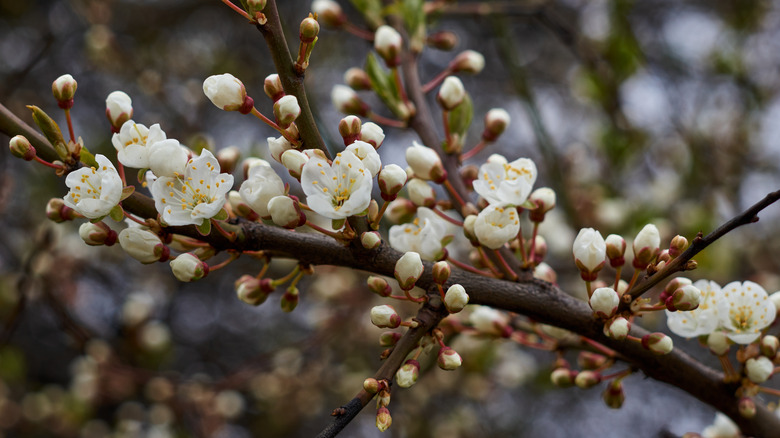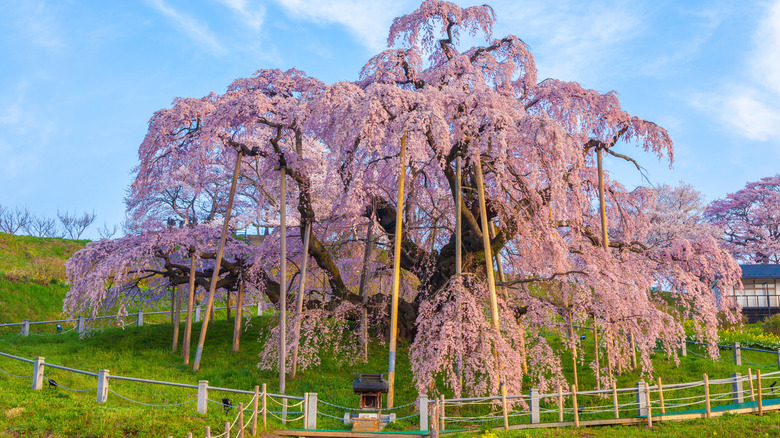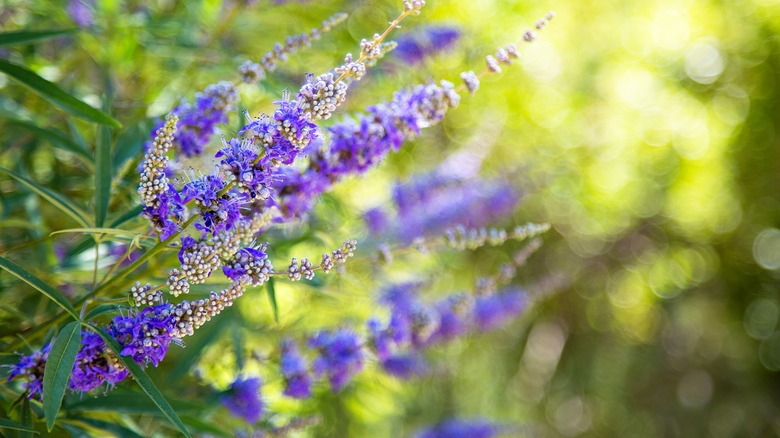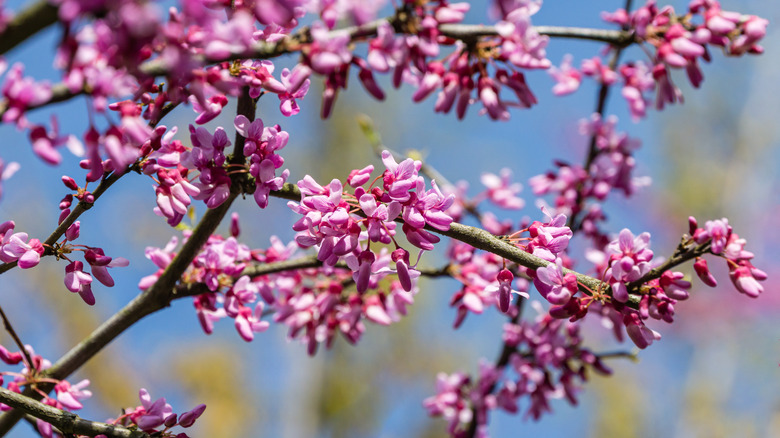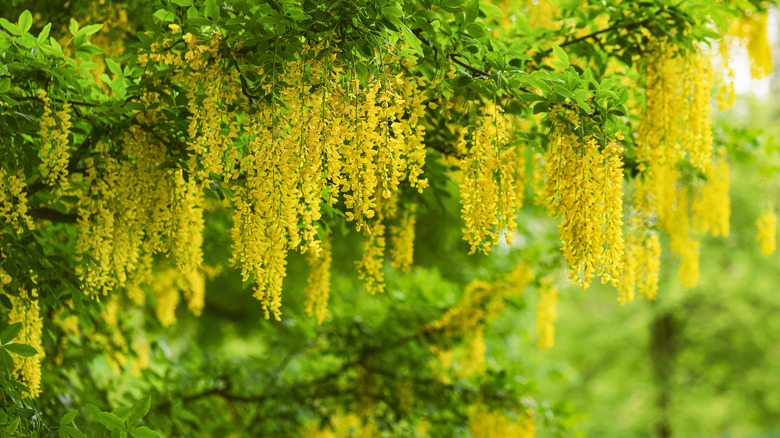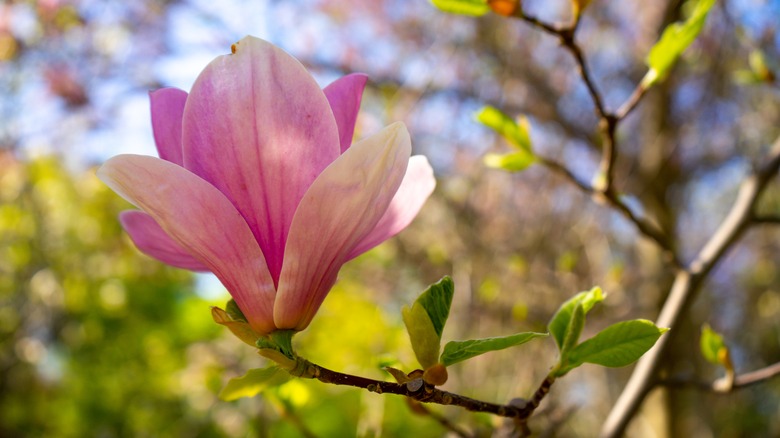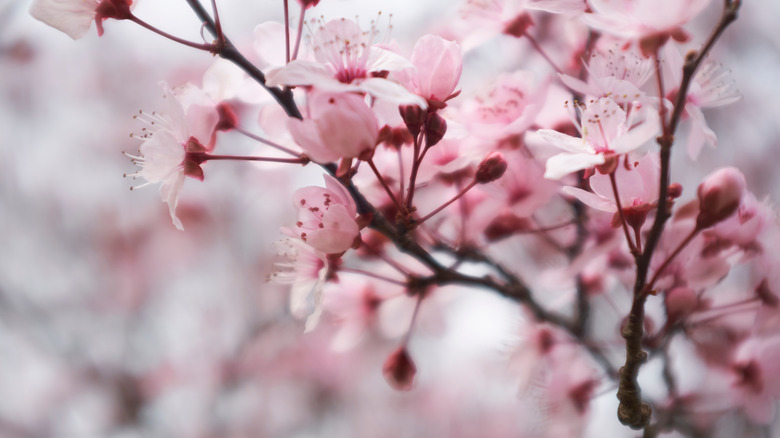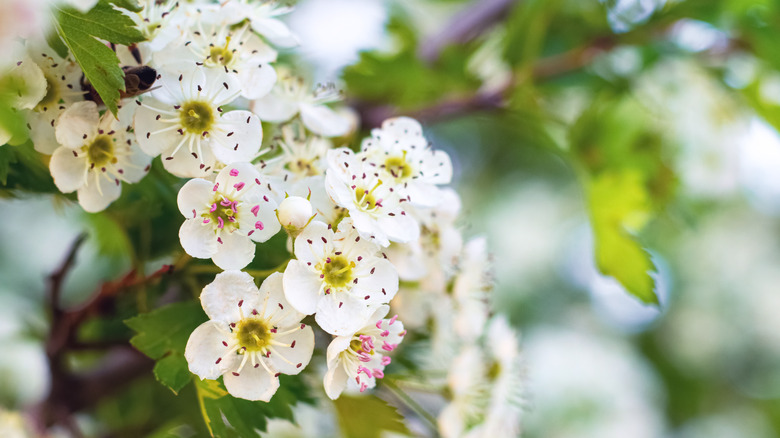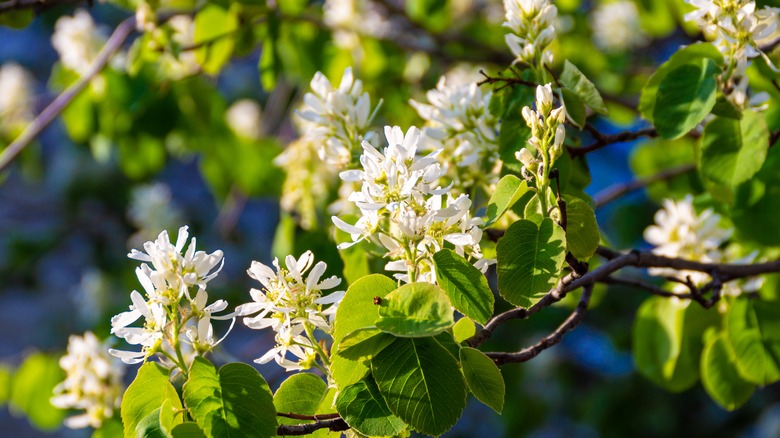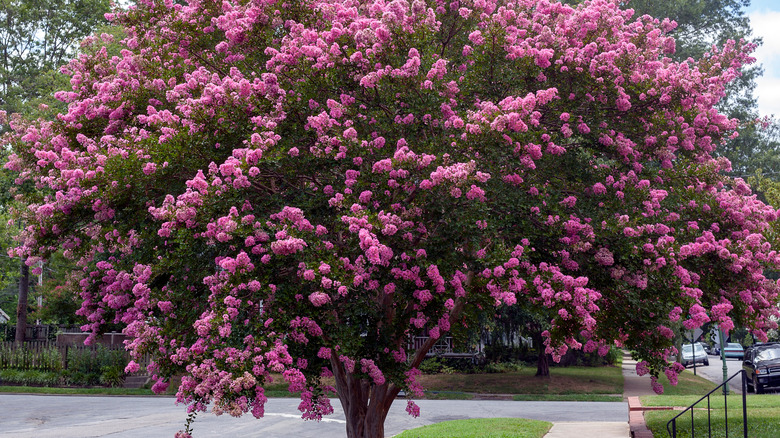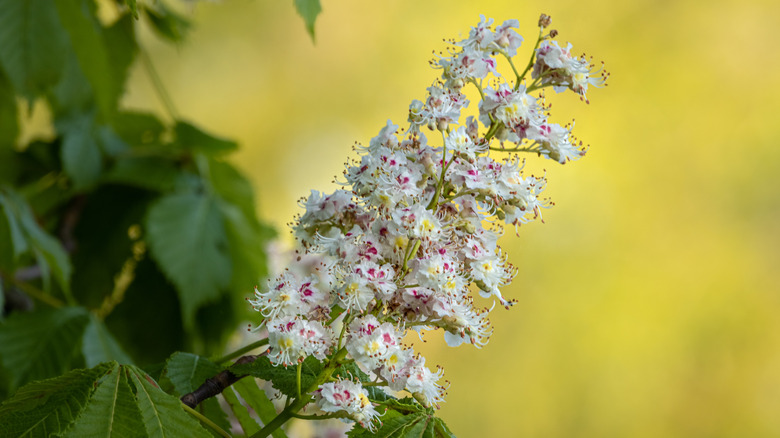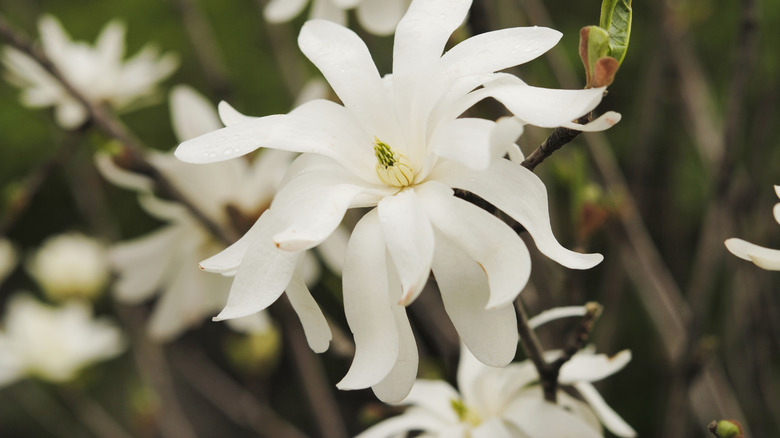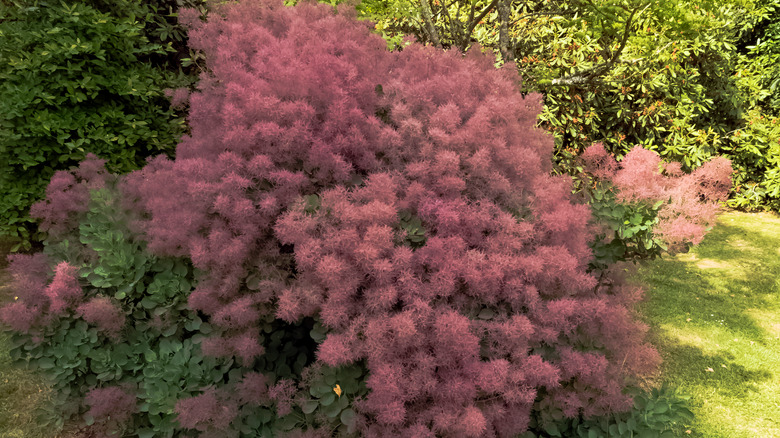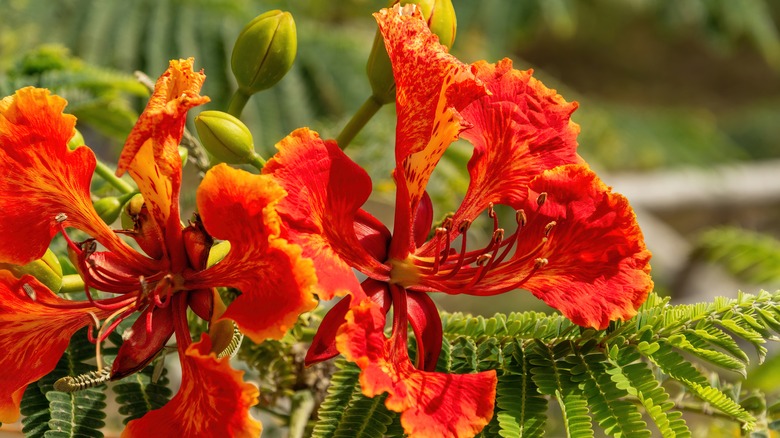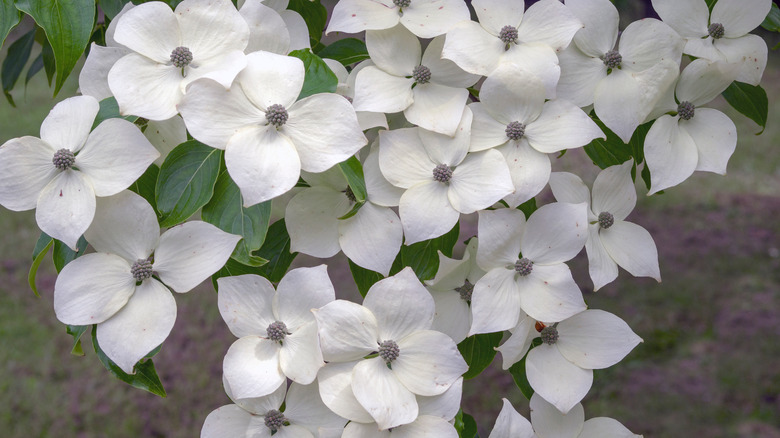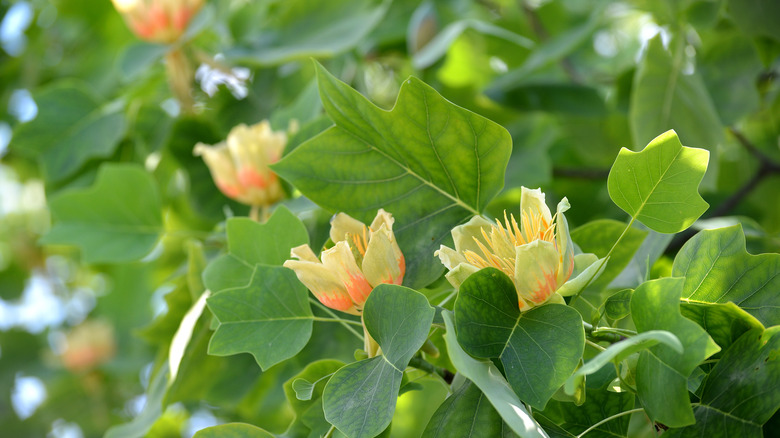15 Flowering Trees That Are Perfect For Your Yard
Are you stuck on what you should add to your yard for some personal flair? There are so many plant species to choose from, with different colors, styles, and sizes. Choosing something that not only complements the rest of your yard but meets the needs of your aesthetics and functionalities is also important. Flowering trees are a great addition to those who want something that can serve multiple purposes, Fast Growing Trees says. Not only can they add a touch of beauty to your yard, but they can often provide a pleasant scent, privacy, and fruit to allure birds and animals.
Another benefit of planting or growing a flowering tree is its ability to be eco-friendly, Twin Oaks Landscapes notes. They do this by absorbing the carbon dioxide from the air and replacing it with oxygen. There are plenty of flowering trees to choose from, so let's take a look at a few.
Weeping cherry
Weeping cherry trees (Prunus subhirtella 'Pendula') are one of the most popular varieties of the eight, The Spruce says. With a beautiful pink color draping down the trunk, they give off an elegant and soft appearance. This tree is capable of growing 20 to 30 feet tall and needs partial shade to be healthy, but it can also survive in full sun exposure. For those interested in this flowering tree, you must remember to plant them separately or in small groups. The health of the soil is important to note, as it should be kept moist and well-drained.
Chaste tree
Chaste trees (Vitex agnus-castus) create a spectacle by growing blue flowers with a hint of purple that point in all different directions, according to HGTV. They can grow up to 10 to 20 feet tall, perfect for those with a small yard. Not only that, but their flowers are capable of surviving six to seven months or more, depending on where you live. Those who live in the South during June will see the most vibrant colors, as well as those who live in the Northwest in August. It's also perfect for those who desire an enchanting scent.
Eastern redbud
Although the flowers on the Eastern redbud (Cercis canadensis) may be small, they still make their presence known in early spring by blooming before all the other plants and showcasing their vibrantly pink color, The Spruce says. This flowering tree also comes in different colors, such as red and lavender, while also having the capability of growing 20 to 30 feet high. University of Arkansas System notes that there are also three varieties of this tree, the other two being the mexicana and texenis.
Golden Rain tree
Those who prefer a more subtle flowering tree may take a liking to the golden rain tree (Koelreuteria paniculata). A tree filled with green leaves with subtle yellow flowers that droop over them, this tree is beautiful in its own artful way, HGTV says. This is a flowering tree that is not only 30 feet tall, but the branches also spread out 30 feet wide. The golden rain tree may be a good choice for those with large yawns who are trying to fill up space.
Saucer magnolias
Saucer magnolias (Magnolia x soulangeana) come in a few colors, such as pink, white, and purple, according to The Spruce. They can grow up to 33 feet tall and require full exposure to the sun in order to remain healthy. Their thin branches accentuate the flowers, giving them full attention to those passing by your yard. When planting this flowering tree, keep in mind that it must not be planted in southern exposures to ensure the flowers don't pop up early. The cold weather may harm them.
'Newport' Cherry Plum
HGTV says that not only will the 'Newport' Cherry Plum tree (Prunus cerasifera 'Newportii') be a beautiful feature piece in your yard, but it can also be a great source for making pie or jam. This tree only grows about 15 to 20 feet tall, perfect for homeowners to reach up and pluck their sweet fruit. From summer to fall, the leaves of this fruit tree alter from purple to red, providing a beautiful color change to match the season.
Hawthorn
Hunker says that there are about 200 varieties of hawthorn (Crataegus) to choose from. When they bloom, you'll either get a white, red, or pink color, according to The Spruce. Clusters of flowers are found surrounded by green and shiny leaves during the spring and summer. During fall and winter, its berries become a food source for local birds. For those who like caring for birds, you can also attach birdhouses to the tree and watch a variety of birds pass through your lawn.
Serviceberry
The serviceberry tree (Amelanchier)is known for its ability to evolve throughout the year, according to HGTV. During early spring, the flowers are white, and the berries turn green to red; the berries then turn black with a hint of purple once ripened in the summer. As the flowers and berries change color, the unique gray color of the bark stands out on its own during the winter. Although the tree can grow from 15 to 30 feet tall, it can still fit neatly in a small yard if you can find serviceberry trees with 15-foot wide branches, HGTV says.
Crape Myrtle
No, this isn't a tasty french dessert. Crape myrtle flowering trees (Lagerstroemia indica)are most popular in southern regions, according to The Spruce. The flowers are feminine and frilly, showcasing colors of either pink, white, red, or lavender. If you love the flowers on this tree as much as everyone else, you'll enjoy the long period of the tree showcasing its beauty from the middle of summer to fall.
Japanese horse chestnut
Although peculiar, the flowers on the Japanese horse chestnut tree (Aesculus turbinata) are beautiful and unique. During the summer, the flowers are pointed up straight and attract stunning creatures such as hummingbirds, HGTV says. For those who desire color all year long, this flowering tree is capable of withstanding the seasons and providing its pink, red, and white colors every day of the year, Gardening Know How says.
Star magnolia
Star magnolia's (Magnolia stellata) are known to be quick bloomers and the first to show off their flowers in the spring, according to The Spruce. Just as the name says, they appear in a white star shape, popping out even before the leaves, in March or April. Although it initially grows as a 24-foot shrub, homeowners can cut the shrub down to expose a stem that can be made to look like a trunk. This flower is part of a colony of 210 species, which can be found on 16 different types of trees, Garden Tabs says.
Smoke tree
The smoke tree (Cotinus coggygria) looks exactly as it sounds. When looking at it from a distance, it appears as a stunning pink puff of smoke floating in the air, according to HGTV. When you get closer, purple leaves become visible and contrast nicely against the pink branches. Due to the nature of its puffiness, people like to use these smoke trees as a border between them and their neighbors for privacy and to also spread the beauty of it, according to Gardening Know How.
Red bird of paradise
The bright red and yellow colors of the red bird of paradise (Caesalpinia pulcherrima) are sure to catch the eye of anyone wandering by. Although considered a shrub, this flowering plant can also take on the look of a tree due to its ability to grow 20 feet high, The Spruce says. It can also spread to about 12 feet wide, so it is important to cut the edges around the base to imitate a tree. This plant would be perfect for dry conditions as it doesn't need much water and prefers areas of drought.
Wolf eyes
This flowering tree only grows about 10 feet tall, but the beauty of its flowers, as they bloom immensely while later changing colors, can look gorgeous in most lawns, The Spruce says. The wolf eyes (Cornus kousa) is part of the kousa dogwood family, which is home to over a variety of 100 species, What Grows There notes. Later on, after the flowers have bloomed, bright red berries then take their place. In the fall, the plant continues to change as the leaves develop stripes of red and pink.
Tulip tree
For those who love tulips, well, you can have a whole tree of them. The tulip tree (Liriodendron tulipifera) produces flowers that are yellow and orange, adding a bit of sunshine to your lawn, according to The Spruce. However, this flowering tree is definitely for those with larger lawns, as it can grow up to 60 or 90 feet. But because it is large, you can create a quaint sitting area underneath as it provides ample shade.
